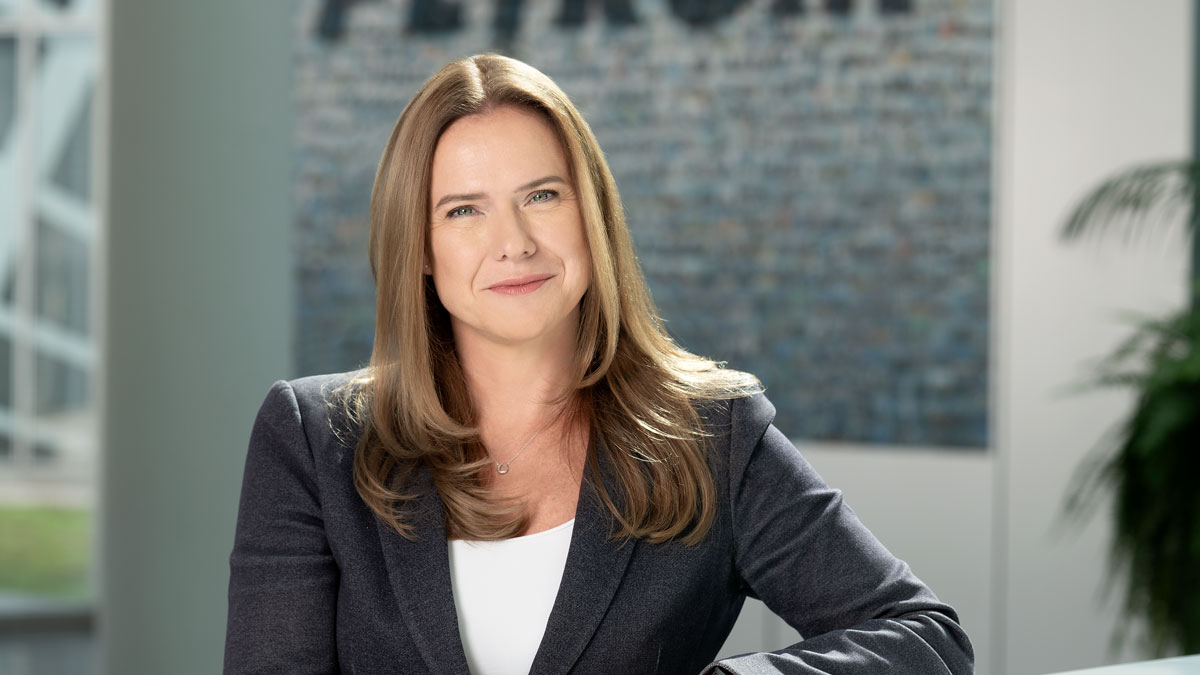Christina Verchere: Black Sea Gas to Underpin Key Attributes for Romania
The energy transition is a pathway toward transformation of the global energy sector from fossil-based to zero-carbon by the second half of this century. We had a conversation with Christina Verchere – Chief Executive Officer and President of the Executive Board of OMV Petrom, about Romania’s role during this process, the company’s approach to sustainability and top business goals for 2021.
OMV Petrom is the largest energy company in South-Eastern Europe, with an annual hydrocarbon production of 152 thousand barrels per day in 2019. The company has a refining capacity of 4.5 million tons annually and operates an 860 MW high-efficiency power plant. The company is present on the oil products retail market in Romania and neighbouring countries through 798 filling stations, at the end of 2020, under two brands – OMV and Petrom. Overall, OMV Petrom provides up to 40% of the fuel and gas market and up to 10% of electricity market in Romania.
Christina Verchere holds a Master degree in Economics Science from the University of Aberdeen, Scotland. She started her career in 1993 and has spent over 20 years with oil and gas supermajor BP, where she held numerous leadership positions in the UK, the US, Canada, and Indonesia. During 2012-2014, she was the Regional President Canada of BP based in Calgary and during 2014 – 2018, she was the Regional President of the Asia Pacific region for BP, located in Jakarta, Indonesia. She became Chief Executive Officer and President of the Executive Board of OMV Petrom on May 1, 2018.
Dear Mrs. Verchere, you are having rich experience of serving the oil and gas industry for many years. During a time of transformation of the global energy sector from fossil-based to zero-carbon we are facing now, what role can you see Romania playing in the energy transition process?
Christina Verchere: Starting with the Paris Agreement, the energy landscape is undergoing a profound transformation, driven by new emerging technologies, public policies designed to encourage the reduction of carbon emissions and by the changes in the consumers’ expectations, who demand energy to be affordable, clean and without interruptions.
At the same time the oil and gas sector is of critical importance for the well-being of people and society by providing energy, as well as being a key contributor to the objectives of sustainable economic development particularly in Romania. The Romanian economy relies heavily on its natural resources and the energy industry generates a significant share of Romania’s GDP, with thousands of employees, with high scale investments as well as taxes and its spill over effects.
And it is the balance of both of these roles that are fundamental for Romania. To find the win-win of both economic prosperity as well as contributing towards the Green Deal and climate change agenda.
Giving the need to address the 2030 and 2050 climate targets and to stimulate a sustainable post-pandemic economic growth, natural gas can be the fuel of choice to reshape the Romanian energy system and to generate a sustainable welfare. For this reason, I believe that Romania is in a unique position to become a best-case scenario in order to use natural gas to turn vulnerabilities into opportunities in energy production and road transportation.
According to the Romania’s National Energy Strategy, by 2030, the country expects to shut down a large chunk of coal-fired electricity generation capacity. Natural gas is the most efficient solution to ensure the necessary electricity and to ensure the flexibility of the energy sector and security of supply with a low carbon energy production.
In addition, Romania has the oldest passenger car park in EU and is placed among the top 3 EU countries with the oldest fleet of light commercial vehicles and heavy transport. CNG and LNG can be a viable fuel in terms of cost efficiency for all types of transport, as long as the premises for developing the refuelling infrastructure will be in place.
The issue of the decarbonisation of the gas sector in Europe poses great challenges for traditional players across the gas industry in the region, as it has been made clear that gas has a limited future in the EU unless it can show how it will contribute to achieving a net zero emissions target by 2050. What is OMV Petrom’s approach to this subject?
Christina Verchere: We want to be part of the solution and believe it will take a mix of energy sources and technological solutions to make the transition possible. Natural gas can play a key role – generating quick wins by replacing other more carbon intensive fossil fuels in the energy production, as well as partnering with renewable sources to ensure uninterrupted power supply. In addition, natural gas is a sustainable fuel option for heavy transportation when covering considerable distances.
Natural gas is the most versatile fossil fuel – it can be stored, compressed, liquefied, or separated into hydrogen and carbon, with multiple applications in all the sectors that are the backbone of the EU economic competitiveness. The energy sector, transportation, agriculture, construction, and the heavy industry will pursue a major structural transformation in the coming years, and, in terms of costs, range, eco-efficiency and infrastructure, gas is the most cost-affordable solution.
Looking beyond the 2030 climate objectives, natural gas also provides a realistic pathway to decarbonisation via conversion to hydrogen. This can, on the one hand, ensure a long-term market share for natural gas and, on the other hand, allow the development of other hydrogen production technologies based on renewables.
The European Commission placed exploiting Black Sea reserves among its priorities in the first EU Energy Security Strategy. BRUA is pivotal among the projects that Brussels is supporting to carry gas along a route from Bulgaria, Romania, and Hungary to the Baumgarten hub in Austria. How do you evaluate and select the most efficient route to market?
Christina Verchere: Two key factors play a role in energy security for a country – firstly access to one’s own natural resources. Moreover, for Romania, the Black Sea gas is an opportunity that few other countries have. This resource can underpin the energy security for Romania and fuel the growth of many other industries, horizontally.
A second key part of energy security is access to markets – either to access product or to sell it. Traditionally Romania has been an isolated gas market with very limited pipeline links to other countries.
In this context, the BRUA pipeline enables further diversification of sources of natural gas supply for the region. The completion of BRUA shows that Romania can implement and complete strategic energy infrastructure projects, essential not only for the country’s energy security, but also for the Central and Eastern European region. BRUA gives for Romania the possibility to have a wider regional presence by playing a lead role in integrating the Eastern and Central European natural gas markets and thus increasing the security of supply. It strengthens the regional competition and enables, for consumers, a multitude of supply sources, while decarbonizing the economies dependent on the coal production.
Romania is currently the EU’s second-largest gas producer after the Netherlands. In case of development, offshore Black Sea production is also expected to play a strategic role in Romania’s future energy mix. If Black Sea gas will be exploited do you think Romania could become the EU’s number one gas producer?
Christina Verchere: Romania definitely has the potential to become the largest producer of natural gas in the European Union and this is a reason for national pride. To do this, Romania must take a step forward towards a new stage of energy sector growth with development of gas from the Black Sea.
Most importantly, the Black Sea can underpin three key attributes for Romania.
Firstly, it has high potential to lead Romania’s post-pandemic economic recovery. We are talking about new revenue streams for the Romanian state budget valued by Deloitte at 1.2 billion USD per year during production stages.
Secondly, as mentioned earlier, it provides the opportunity to use a national resource to contribute to Romania’s efforts to fulfil its carbon reduction targets.
And thirdly, it underpins Romania’s energy security turning it from a net importer to ensuring its own energy needs are met.
The new Offshore Law amendments, long awaited by operators in the oil and gas industry, have given rise to countless contradictory debates. What are, in your opinion, the mandatory provisions of a legislation that would encourage investors?
Christina Verchere: Investors look for several traits in the legislative environment of a country. The most commonly discussed is stability and predictability and this is particularly the case for the Black Sea investors given the large scale of the projects, with a long investment cycle.
Another is competitive fiscal terms. Investors need to see that Romania is a place that is open for business by offering terms that are in line with other markets they are considering. Currently, comparing with the EU average level of taxation, Romania’s fiscal terms are 3 times higher for onshore and 5 times higher for the offshore production. Romania has to compete as part of a global capital market and at a time where oil and gas companies are reducing their investment levels worldwide. And thirdly, investors look at the right to freely market their products in line with EU legislation.
These are some of the key factors for evaluating projects all over the world.
The investments in the campaign of exploration of the Black Sea resources have reached impressive figures, not to mention the amounts necessary for exploitation and the extensive range of assumed risks. How are all these justified?
Christina Verchere: Oil and gas exploration and development is a very capital-intensive industry, with a high investment risk.
Just to give you an example, in onshore exploration only one out of three wells is successful. Deep-water offshore development involves multi-billion investments because the operations take place in more complex environments by being, firstly offshore, but also the water depth, triggering utilization of very specific equipment and technology and skilled work force.
Until present, over 1.5 billion USD were invested just in exploration and appraisal activities in the Neptun Deep block. In order to get the resources out of the ground, additional multibillion USD investments are required in the development phase for the offshore and onshore facilities, pipelines and wells.
To be successful, government and industry must work together to find effective ways to expand supplies while increasing energy efficiency and reducing environmental impact. As industry needs to innovate, what are OMV Petrom’s most significant accomplishments in this respect? Is it difficult to introduce digital culture across a large company like yours?
Christina Verchere: Reaching carbon neutrality by 2050 will require structural transformations for the energy system and implies fundamental changes in our life, as consumers. We believe that innovation, digitalization, and new technologies are the driving forces to become more agile and face any kind of challenges, while reducing the carbon footprint.
At OMV Petrom we want to be part of the solution and, through sustained investments, the intensity of carbon emissions from our operations has decreased by 22% in 2019 compared to 2010.
In the last years, we commissioned several large projects which, using innovative and state-of-the-art technologies, have contributed to improving the environmental footprint. These include the Polyfuels unit at the Petrobrazi refinery and the Hurezani gas hub in Asset Oltenia, with total investments of EUR 115 million.
Our sustained efforts continued this year. We increased our upstream operational efficiency, we installed photovoltaic panels in over 70 filling stations to increase the share of green energy used in our stations and we have concluded two partnerships with Eldrive and Enel X to install 40 recharging points for electric vehicles, in order to have a mix of fuels in our filling stations.
Though the pandemic has been very challenging, I believe it has accelerated some of the digital skills and tools that we are now using. With around 5,000 of our employees working at home we quickly had to move to a more paperless work environment with digital signatures and virtual meetings. We had been working on these projects, but the pace of adoption became lightening in speed once we were remote. And the digital acceleration is not just internal – we are also now installing a pay at the pump option in some of our newly modernized Petrom filling stations.
The improvement of safety performance continues to be a major challenge for the oil and gas companies. What are the ‘best cards’ of OMV Petrom in this regard?
Christina Verchere: The oil and gas industry is a high hazard industry and the safety of our people is our number one priority.
Our HSSE vision is zero harm – no losses and that means that we believe that all accidents and losses can be prevented, with a strong safety culture, by having the right processes in place and by nurturing a culture of learning.
Safety is a state of mind; therefore, a matter of organizational culture and one we look to instil in all our employees and contractors in both the front line and those that are office based. At the heart of safety is truly caring for each other, being prepared to say when you see something that is not correct and recognizing people for their increased attention for the safety rules.
We have had a big focus on road safety with monitoring systems in all our vehicles, defensive driving training and big campaigns on raising awareness around wearing seatbelts (in the front and the back seats of the vehicle).
Overall, we have made important improvements in our safety performance. Safety is a continuous journey that you can never stop focusing on and learning from incidents to improve.
We are continuously monitoring the HSSE performance to support the development of a strong and mature HSSE culture.
What are OMV Petrom’s main challenges and top goals for 2021? How do you expect to face these challenges?
Christina Verchere: Our foremost role in society is to provide Romania with the energy it needs, without interruption.
We provide 40% of Romania’s demand for fuels and gas and up to 10% of the electricity domestic production, so we play a significant role in the energy landscape.
2020 has been a challenging year for all of us and I am pleased we ensured energy supply for all our customers without interruption. And this of course will be our goal in 2021. We hope, like all, with the discovery of anti-Covid vaccines, we will have the chance to get out of this dark period.
Secondly, the economic landscape will be shaped by the climate objectives that we must achieve in 2030. The restart of the economic engines depends on this and Romania is in the position to benefit from both private investment and European funds to achieve its sustainable development goals.
We strongly believe that Black Sea projects can be one of the engines for Romania’s post CoVid-19 recovery. It is a unique opportunity, one of the few big private sector investment projects, which is ready to start, also contributing to the reduction of carbon emissions from the energy sector and from heavy long-distance road transport.
Despite the fact that the oil and gas industry faces the biggest crisis in 100 years, it still has a high potential to become an engine of economic recovery, with the appropriate measures in place.
COVID-19 has dramatic impacts on the energy industry, as well as the severely depressed oil price environment accompanied by a weakening economic situation. What measures do you envisage to deal with these issues?
Christina Verchere: OMV Petrom had to face an unprecedented crisis that unfolded on three layers: dealing with the pandemic and the isolation measures while continuing to ensure energy supply, rapid oil price decline and drastic drop in petroleum products demand. As a sector we have faced drops in oil price before but never at the same time as such a dramatic drop in demand.
Therefore, our priorities during this period focused on protecting our employees that are working in key assets, to ensure the fuel production and continuous flow of energy that Romania needs.
At the same time, we reorganized the way we work for our employees now working at home, in order to rely on online communication tools.
At the business level, we made a number of decisions to protect the company’s health, reducing our investment levels by postponing activities.
These measures, which ensured the protection of employees and the health of our company, remain a priority, allowing us to supply fuels, electricity, and natural gas without interruption.
In your opinion, how will the international energy market change, given the high energy demand but also the decrease of the world hydrocarbons resources? Is renewable energy a solution for the world economy during this time of crisis? Is it a solution for the future?
Christina Verchere: A low carbon energy system requires an optimal blending between low carbon mature technologies (ex: gas to power, CHP) and new technologies expecting to be deployed, in the next ten years, on a large scale in the energy system. (e.g.: Carbon Capture and Storage, battery storage, electrolysis, and pyrolysis for hydrogen production etc.)
Renewables and gas go hand in hand; they are no longer just an alternative in the electricity production. They are a mainstream source and, ramped up with smart energy management systems (e.g. smart grids, smart metering etc.), will shape the energy system in the coming years.







